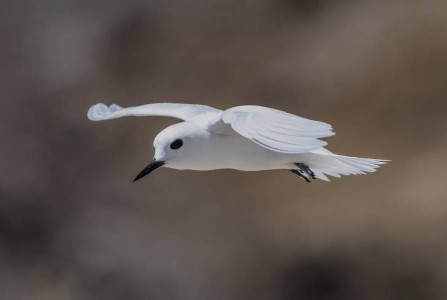Conservation > Discover > Flora and Fauna > White tern

Type: Seabird | Status: Least Concern | Nativeness: Native
These inquisitive terns are known locally on Ascension as Fairy terns. These delightful birds will regularly approach hikers and momentarily hover in the air above. These flybys are curious, not aggressive, and are an excellent moment to photograph the translucent, ethereal quality of their wings lit from above.
White terns would have originally solely nested on small cliff ledges on Ascension, given the limited native plant life. They have since adapted to the mass introduction of plant species to the island in the mid-1800s. Now the tall Eucalypts that grow around the mountain are also popular nest sites. Like other white terns around the world, they do not build a nest at all. Instead a breeding pair will find a branch with a small hollow or suitable fork, or a suitable cliff ledge, and lay an egg directly on that surface. Both parents share incubation and chicks fledge at around 7 weeks. Egg dates will vary throughout the year.
They can be found across the island, where there are suitable cliffs or trees. This species tends to remain close to the island all year round and these birds can often be seen in pairs performing synchronised acrobatics. The best place to see them is Green Mountain National Park, where many nest in the trees right by the road. Letterbox, Louis’ Ledge, the cliffs of Weatherpost and Hummock Point are also good places to view them.
“Fairy” or White terns feed on a variety of small fish which they catch using a dipping technique. Fish are carried whole to the chicks rather than regurgitated. Small, with a wingspan of 70-87cm, their plumage is an all over white, sometimes slightly cream. The legs are dark, as is the pointed beak and there is a narrow black eye ring that makes their dark eyes appear larger. Juveniles differ from adults in the have a black spot behind the eye and brownish mottling on nape. They can also present with greyish to black in parts of plumage.
This Seabird can be found in the following locations:
Green Mountain National Park is full of history and natural beauty. Rising to 859m, the mountain is lush and cool compared to the arid lowlands, with many trails for visitors to explore.
A remote nature reserve home to many seabird species and stunning geological scenery.
[wp_rss_retriever url="https://rss.app/feeds/MNrgI5Ybn5Se8Pg6.xml" items="1" excerpt="0" read_more="true" title="true" source="false" credits="false" new_window="true" thumbnail="false" date="true" ajax="false" cache="3600"]
